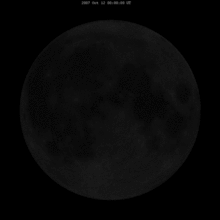- Near side of the Moon
-
The near side of the Moon is the lunar hemisphere that is permanently turned towards the Earth, whereas the opposite side is the far side of the Moon. Only one side of the Moon is visible from Earth because the Moon rotates about its spin axis at the same rate that the Moon orbits the Earth, a situation known as synchronous rotation or tidal locking. The Moon is directly illuminated by the Sun, and the cyclically varying viewing conditions cause the lunar phases. The unilluminated portions of the Moon can sometimes be dimly seen as a result of earthshine, which is sunlight reflected off the surface of the Earth and onto the Moon. Since the Moon's orbit is both somewhat elliptical, and inclined to its equatorial plane, librations allow up to 59% of the Moon's surface to be viewed from Earth (but only half at any instant from any point).
Contents
Names
The near side of the Moon is characterised by large dark areas that were once believed to be seas by astronomers who first mapped them in the 17th century (notably, Giovanni Battista Riccioli and Francesco Maria Grimaldi). Although it was found out later that the Moon has no seas, the term "mare" (plural: maria) are still used. The lighter toned regions are referred to as "terrae", or more commonly, the "highlands".
Orientation
The image of the Moon here is drawn as is normally shown on maps, that is with north on top and west to the left. Astronomers usually turn the map over to have south on top, as to correspond with the view in most telescopes which also show the image upside down.
Note that west and east on the Moon are where you would expect them, when standing on the Moon.. But when we, on Earth, see the Moon in the sky, then the east — west direction is just reversed. When specifying coordinates on the Moon it should therefore always be mentioned whether geographic (or rather selenographic) coordinates are used or astronomical coordinates.
The actual orientation you see the Moon in the sky or on the horizon depends on your geographic latitude on Earth. In the following description a few typical cases will be considered.
- On the north pole, if the Moon is visible, it stands low above the horizon with its north pole up.
- In mid northern latitudes (North America, Europe, Asia) the Moon rises in the east with its northeastern limb up (Mare Crisium), it reaches it highest point in the south with its north on top, and sets in the west with its northwestern limb (Mare Imbrium) on top.
- On the equator, when the Moon rises in the east, its N — S axis appears horizontal and Mare Foecunditatis is on top. When it sets in the west, about 12.5 hours later, the axis is still horizontal, and Oceanus Procellarum is the last area to dip below the horizon. In between these events, the Moon reached its highest point in the zenith and then its selenographic directions are lined up with those on Earth.
- In mid southern latitudes (South America, South Pacific, Australia, South Africa) the Moon rises in the east with its southeastern limb up (Mare Nectaris), it reaches it highest point in the north with its south on top, and sets in the west with its southwestern limb (Mare Humorum) on top.
- On the south pole the Moon behaves as on the north pole, but there it appears with its south pole up.
See also
External links
- Lunar and Planetary Institute: Exploring the Moon
- Lunar and Planetary Institute: Lunar Atlases
- Ralph Aeschliman Planetary Cartography and Graphics: Lunar Maps
The Moon Physical features 
Orbit Lunar surface - Selenography
- Near side
- Far side
- Lunar mare
- (List)
- Craters
- (List)
- Mountains
- Valleys
- South Pole – Aitken basin
- Shackleton crater
- Water
- Soil
- Peak of eternal light
- Space weathering
- Transient lunar phenomenon
Lunar science Exploration Other topics - See also Solar System
- Natural satellite
Categories:- Lunar science
Wikimedia Foundation. 2010.



